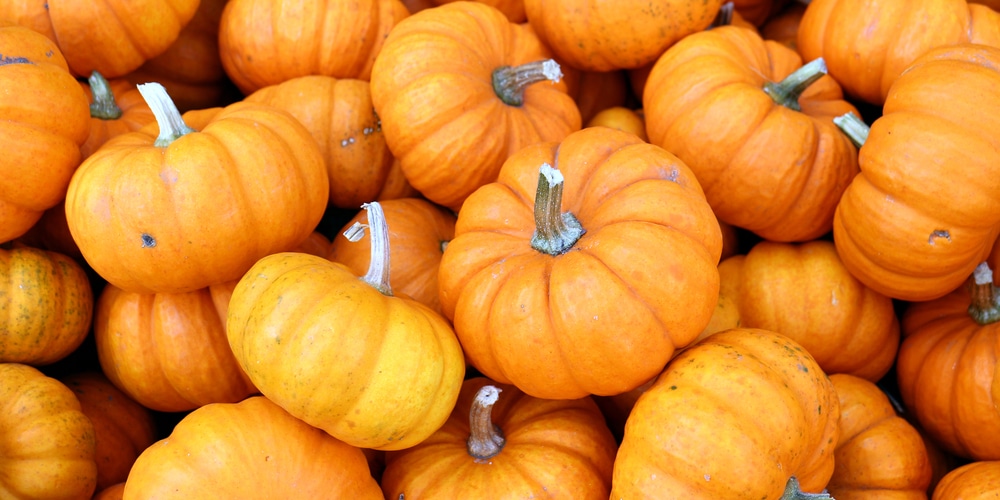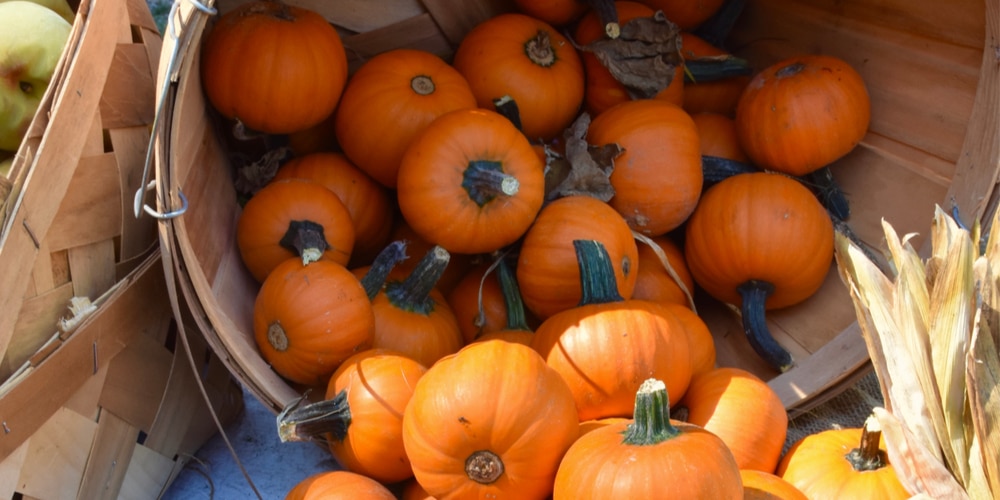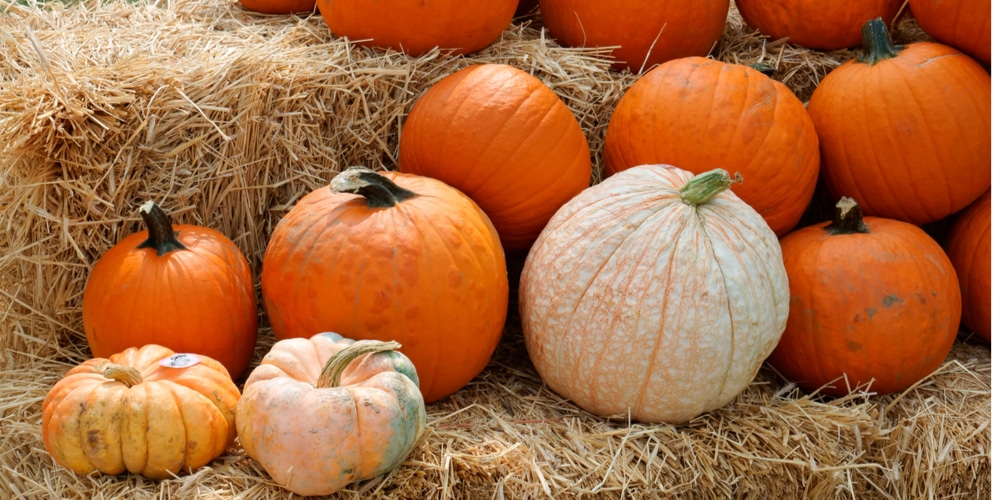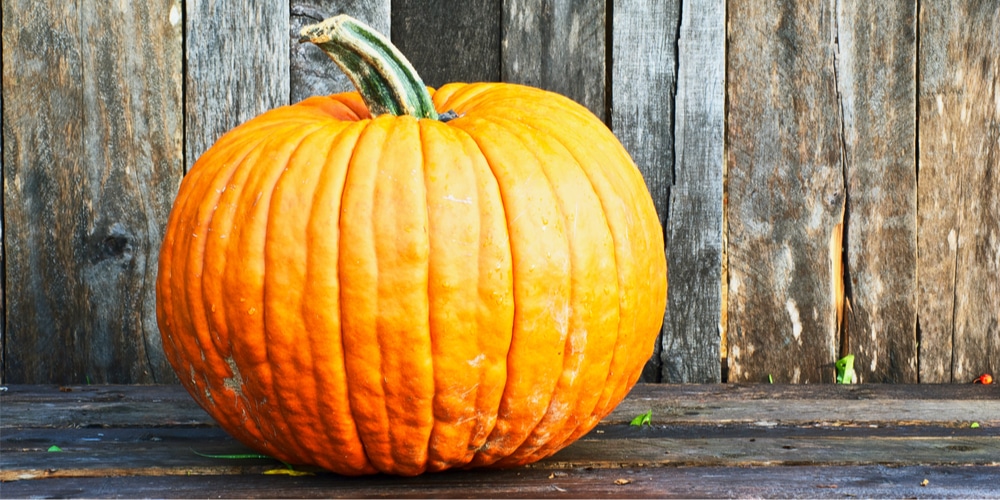If you’re wondering, ‘how much do pumpkins weigh?’ you’ve found the right article. We’ll look at some of the most common types of pumpkins grown by gardeners and discuss their average weight.
Various varieties of pumpkins are available in different sizes. If you’re planning to win a pumpkin growing contest, you’ll need to choose a type with a good chance of growing to a giant size. Giant pumpkin generally grows to a weight of between 100 and 300 lbs. but with the proper care and attention, can get as large as 1,000 lbs. or more in weight.
If, on the other hand, you want to grow a jack-o-lantern pumpkin for Halloween, you can choose a much smaller variety. Most small to medium-sized pumpkins weigh up to 30 lbs, while the mini types weigh just 1/4 lb.
| Pumpkin Type (Examples) | Weight |
|---|---|
| Mini (Apprentice, Baby Boo, Jack be little, Baby Pam) | 1 lb |
| Small (small sugar, early abundance, cannonball) | 5-7 lbs |
| Medium (Casper, Musquee De Provence, Connecticut Field, Secretariat) | 15-20 lbs |
| Large (Early King, Gladiator, Howden, Bunch O' Warts) | 25-30 lbs |
| Giant (Atlantic Giant, Growers Giant, and Prizewinner, Big Max) | 100-300 lbs |
Weight of Mini Pumpkin Varieties
Pumpkins are known to spread far and wide, and the amount of space they take up often puts gardeners off growing these taste fall vegetables. If you have a smaller gardening plot, you may like to choose a mini pumpkin variety. These not only take up less space but also produce smaller pumpkins.
Mini pumpkins generally weigh less than a pound at harvest time and include Apprentice, Baby Boo, Jack be little, and the slightly larger Baby Pam. These pumpkins take up to three months to reach maturity and can be used to create small lanterns or used in various dishes.
Small Pumpkin Varieties Weight
Small pumpkins weigh between five and seven pounds and can take up to 110 days to reach maturity. Popular small pumpkin varieties include small sugar, early abundance, and cannonball. Small pumpkins are usually grown to eat and can be used to make pumpkin pie. They are also great for anyone who wants to make a smaller jack-o-lantern.
Medium Pumpkin Varieties
When most people picture a pumpkin, they think of a medium-sized pumpkin that is commonly used to make jack-o-lanterns. These types of pumpkins can also be used for cooking and weigh between 15 and 20 lbs. Some examples of medium-sized pumpkins include Casper, Musquee De Provence, Connecticut Field, and Secretariat. These pumpkins take slightly longer to grow and mature, so you’ll need to ensure you plant them in good time if you want your pumpkins to be ready before Halloween. Pumpkins take an average of 120 days to reach their full weight.
Large pumpkin varieties
Large pumpkins weigh between 25 and 30lbs. and include varieties such as Early King, Gladiator, Howden, and the spookily names Bunch ‘o Warts. These pumpkins take between 90 and 115 days to reach maturity.
Giant pumpkin varieties
The Guinness Book of World Records states that the largest pumpkin in the world weighed a staggering 2,625 lbs. The pumpkin was grown in Belgium by Mathias Willemijns and won the 2016 European Giant Pumpkin Contest. Mathias won $11,460.
If you’re looking to enter a pumpkin contest, you’ll need to ensure you choose a giant variety of pumpkin. The Atlantic Giant, Growers Giant, and Prizewinner can all grow up to 300lbs with the right care and attention. Big Max is slightly smaller but can reach 100lbs at maturity. These pumpkin varieties take 120 days to grow.
Tips for growing a giant pumpkin
Growing giant pumpkins is a very popular hobby that seems to be a global pastime. Many of the largest pumpkins grown have been the Atlantic Giant variety. Growing a giant pumpkin takes gardeners a lot of planning. You’ll need to have a large garden with up to 1,500 square feet of space. Your pumpkin plant needs to be correctly cared for and provided with adequate water and nutrients.
Another tip for growing a prize-winning pumpkin is to prune your plant so that only one pumpkin is growing. This will allow the plant to put all its energy into growing a single large fruit. Once your pumpkin plant starts to produce flowers, it should be regularly fertilized using either an all-purpose vegetable fertilizer or a nitrogen-rich fertilizer. You can also provide your plant with a bloom booster fertilizer that has an NPK ratio of 1-2-2.
Conclusion
As you can see, there are a large variety of pumpkin types that will weigh different amounts. The type you choose to plant will depend on your purpose for growing pumpkins. Pumpkins go through many growth stages as they ad weight. The fruits are commonly grown for jack-o-lanterns, pumpkin pies, or pumpkin contests and can be harvested in the fall.




